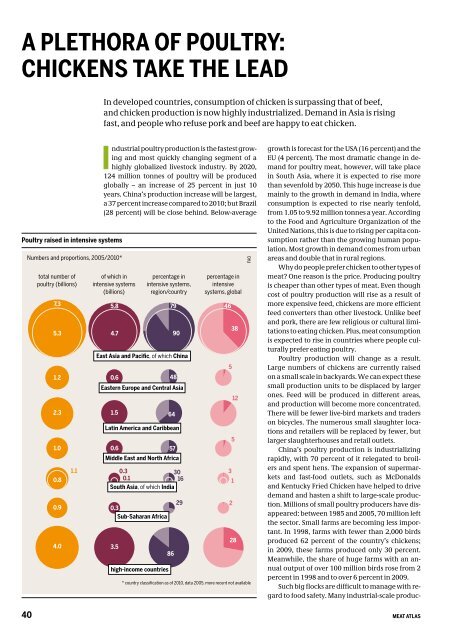1jjtwKx
1jjtwKx
1jjtwKx
You also want an ePaper? Increase the reach of your titles
YUMPU automatically turns print PDFs into web optimized ePapers that Google loves.
A PLETHORA OF POULTRY:CHICKENS TAKE THE LEADIn developed countries, consumption of chicken is surpassing that of beef,and chicken production is now highly industrialized. Demand in Asia is risingfast, and people who refuse pork and beef are happy to eat chicken.Poultry raised in intensive systems40Numbers and proportions, 2005/2010*total number ofpoultry (billions)7.35.31.22.31.00.80.94.01.1Industrial poultry production is the fastest growingand most quickly changing segment of ahighly globalized livestock industry. By 2020,124 million tonnes of poultry will be producedglobally – an increase of 25 percent in just 10years. China’s production increase will be largest,a 37 percent increase compared to 2010; but Brazil(28 percent) will be close behind. Below-averageof which inintensive systems(billions)5.84.70.648Eastern Europe and Central Asia1.50.657Middle East and North Africa0.3300.116South Asia, of which India0.3Sub-Saharan Africa3.5percentage inintensive systems,region/country79648690East Asia and Pacific, of which ChinaLatin America and Caribbeanhigh-income countries29percentage inintensivesystems, global46* country classification as of 2010, data 2005, more recent not available53812531228FAOgrowth is forecast for the USA (16 percent) and theEU (4 percent). The most dramatic change in demandfor poultry meat, however, will take placein South Asia, where it is expected to rise morethan sevenfold by 2050. This huge increase is duemainly to the growth in demand in India, whereconsumption is expected to rise nearly tenfold,from 1.05 to 9.92 million tonnes a year. Accordingto the Food and Agriculture Organization of theUnited Nations, this is due to rising per capita consumptionrather than the growing human population.Most growth in demand comes from urbanareas and double that in rural regions.Why do people prefer chicken to other types ofmeat? One reason is the price. Producing poultryis cheaper than other types of meat. Even thoughcost of poultry production will rise as a result ofmore expensive feed, chickens are more efficientfeed converters than other livestock. Unlike beefand pork, there are few religious or cultural limitationsto eating chicken. Plus, meat consumptionis expected to rise in countries where people culturallyprefer eating poultry.Poultry production will change as a result.Large numbers of chickens are currently raisedon a small scale in backyards. We can expect thesesmall production units to be displaced by largerones. Feed will be produced in different areas,and production will become more concentrated.There will be fewer live-bird markets and traderson bicycles. The numerous small slaughter locationsand retailers will be replaced by fewer, butlarger slaughterhouses and retail outlets.China’s poultry production is industrializingrapidly, with 70 percent of it relegated to broilersand spent hens. The expansion of supermarketsand fast-food outlets, such as McDonaldsand Kentucky Fried Chicken have helped to drivedemand and hasten a shift to large-scale production.Millions of small poultry producers have disappeared:between 1985 and 2005, 70 million leftthe sector. Small farms are becoming less important.In 1998, farms with fewer than 2,000 birdsproduced 62 percent of the country’s chickens;in 2009, these farms produced only 30 percent.Meanwhile, the share of huge farms with an annualoutput of over 100 million birds rose from 2percent in 1998 and to over 6 percent in 2009.Such big flocks are difficult to manage with regardto food safety. Many industrial-scale produc-MEAT ATLAS


